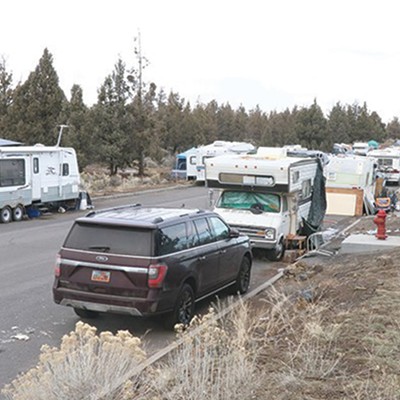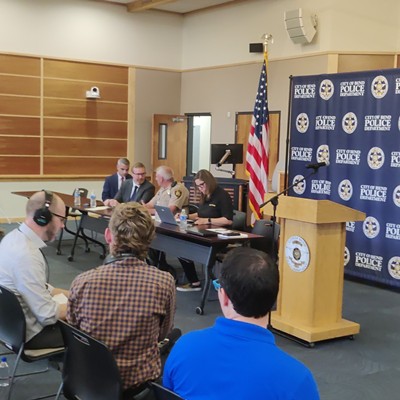Recently I've had some interesting phone calls to my home and travelin' phones, giving me cause to suspect the alien barred owl population (from the eastern United States and Canada) may be on the rise, and people are confusing them with our native great gray owls.
Great grays are owls of the open spaces in the evergreen high country. They like to hang out on the edges of meadows, hiding in the thick foliage of evergreens, waiting for gophers and other meadow dwellers to show their heads. They're very uncommon in juniper and sagebrush country, sticking pretty much to high country pine forests and open meadows.
The barred owl, on the other hand, is a generalist; it can get along with just about any small prey, and as far as I know doesn't give a hoot about what kind of habitat it's in. They are also a great deal smaller then the great gray, and they seem to be popping up more frequently near Bend and Sisters.
Both species look somewhat alike. Both have no horns/ears, both have a very noticeable facial disk, and both have similar coloration. However, the distinct differences are in size and eye color. The great gray is gigantic by comparison (bigger than a great horned owl) and has yellow eyes, while the barred is much smaller (about the size of a small chicken) and have all-black eyes, no exceptions.
Great grays were having a tough time of it not too long back—and still are in some areas, because of habitat loss. Unfortunately, there's a direct conflict between the owls' need for a jackstraw understory, and the forest fire requirements to eliminate that jackstraw understory, known as "ladder fuels." This conflict has been eliminated in some areas with the installation of nesting platforms large enough to allow the owlets to remain in the nest to fledging.
Unfortunately, like most owls, the great gray selects nests that are handy and don't have to even resemble a "nest." They like to choose a nesting site located on the edge of forests, close to their favorite food supply. The so-called "nest" is often a broken-off tree about 20 to 40 feet high. The (sort-of) flat surface with broken parts of the stub seems to meet with approval for great grays. The female lays her eggs in among the stub's debris, fluffs up her skirt and somehow keeps the babies warm as they hatch.
Within two weeks, however, there's no room at the inn. Baby owls—especially great grays—grow very rapidly. Mom and dad are great providers, so within two weeks or so their babies grow to twice their birth size and begin shoving each other around.
If the "nest" is in a broken off lodgepole pine, or an old accipiter nest, and if there are two or more babies, they soon begin pushing against each other so harshly that one or more is pushed out of the nest. Most nests are somewhat out of the way of visitors, so no one comes along to see the "poor little baby owl" on the ground. That's OK though, since nature took care of that business of the great grays falling out of nests a long time ago. Baby great gray owls have enormous feet, and with those long toes, sharp talons and strong legs, they can climb small trees like nobody's business.
That's when the jackstraw understory comes into play. The baby owl climbs to the top of the stick — sometimes doing it vertically—and starts squawking for food. The parents take care of the stranded owl as if it were still in the nest, and often, the youngster will remain on the top of that pole, being taken care of by the adult—even after it fledges.
On the other hand, barred owls will use an old raptor, magpie nest, or pike of sticks that holds all the babies in the nest to fledging time, and as generalists, can make a living on just about anything small that moves within 1/2 mile of the nest, be it birds, frogs, snakes, lizards, mice, gophers or even stinky baby skunks.
But all this may come to naught if a "Tiger of the Air"—the great horned owl—moves into or already occupies the area. No owl is safe when one of those tigers moves in or lives there. Even smaller, cavity-nesting species, such as northern elf, ferruginous, saw-whet, screech and flammulated owls will leave a nesting territory if a great horned shows up.
Years ago I helped to conduct a northern spotted owl survey for the Forest Service. One of the protocols dictated that if a great horned answered the spotted owl survey call, you were to fold up shop and leave the area immediately. South of Gilchrist, I had a calling site like that. All it took was one spotted owl call, and a great horned responded with gusto. I hit the trail, literally.
When it comes to strange calls or sightings, do your best to obtain a "voucher photo." That's really the only way to be sure what you're observing is, or is not, what you think. If you show it to local bird experts such as Tom Crabtree of Bend or Chuck Gates of Powell Butte, you'll find that what they say it is is gospel. Additionally, Oregon Department of Fish and Wildlife non-game biologist Simon Wray of Bend's Central Region office is on top of every call he gets.But even if you don't have a photo, please don't hesitate to share any special wildlife observation you may encounter.
Contact Naturalist Jim Anderson
At [email protected]. Travelin' phone: 541-480-3728, or home phone: 541-388-1659. To reach Simon Wray, contact [email protected].


























